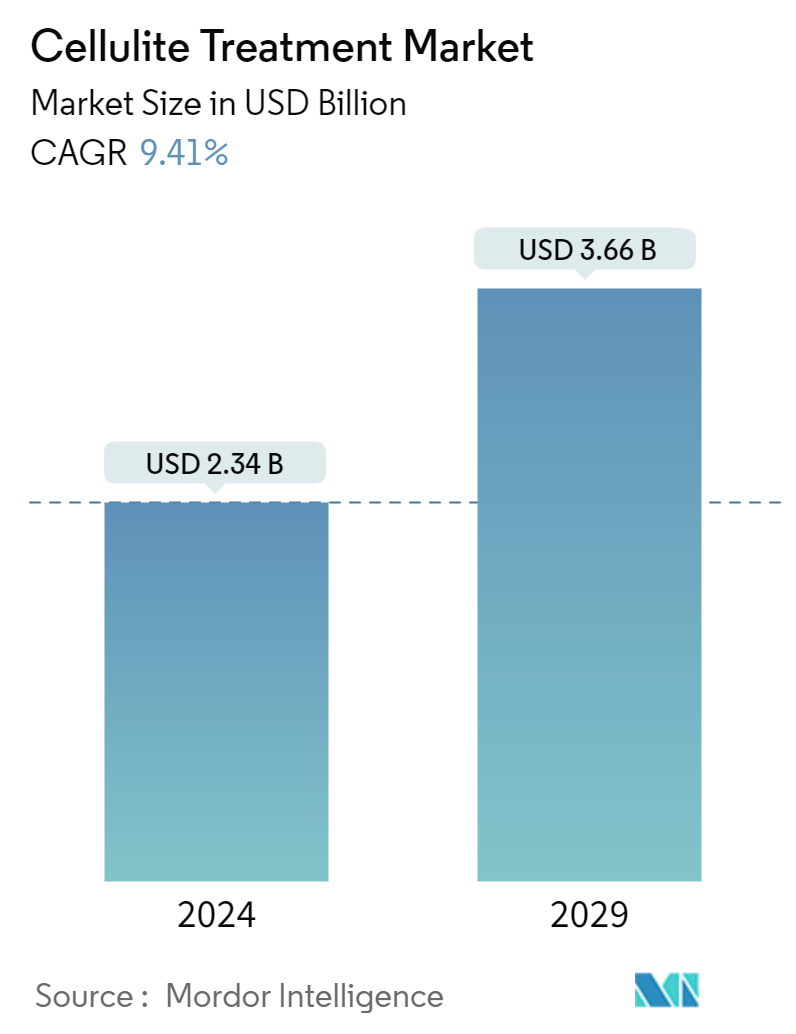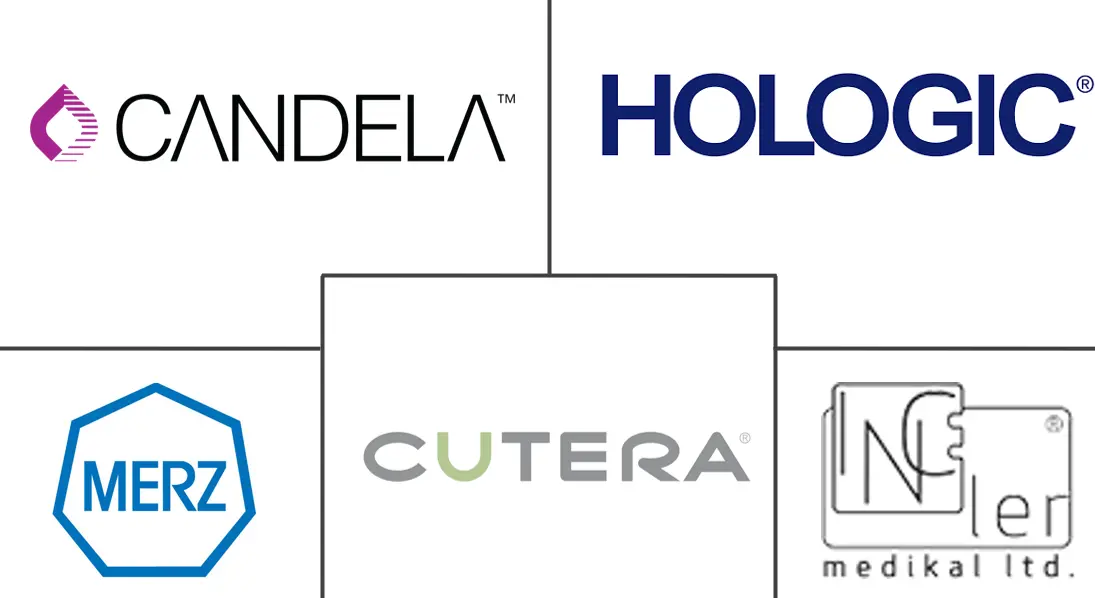Market Size of Cellulite Treatment Industry

| Study Period | 2019 - 2029 |
| Market Size (2024) | USD 2.34 Billion |
| Market Size (2029) | USD 3.66 Billion |
| CAGR (2024 - 2029) | 9.41 % |
| Fastest Growing Market | Asia Pacific |
| Largest Market | North America |
Major Players
*Disclaimer: Major Players sorted in no particular order |
Cellulite Treatment Market Analysis
The Cellulite Treatment Market size is estimated at USD 2.34 billion in 2024, and is expected to reach USD 3.66 billion by 2029, growing at a CAGR of 9.41% during the forecast period (2024-2029).
- The cellulite treatment market has experienced notable growth due to increasing demand for aesthetic treatments and advancements in non-invasive procedures. As the pursuit of solutions for cellulite reduction intensifies, the market has diversified, offering a range of products and services tailored to various consumer preferences and needs.
Market Overview
- Cellulite, characterized by dimpled or lumpy skin, is a condition that affects a significant portion of the population, particularly women. The growing awareness of aesthetic appearances and the availability of advanced treatment technologies have fueled the demand for effective cellulite treatment solutions. The market offers a broad spectrum of options, from non-invasive treatments like laser and radiofrequency therapy to topical creams and lotions, as well as minimally invasive procedures. These advancements have significantly improved the efficacy and safety of treatments, contributing to their rising popularity.
Growing Concern over Obesity and Its Aesthetic Implications
- Global Obesity Epidemic: The global rise in obesity rates is a significant factor driving the cellulite treatment market. As obesity increases, so does the prevalence of cellulite, often associated with excess body fat. Consumers are increasingly opting for non-surgical options to address cellulite, perceiving these methods as safer and more convenient compared to invasive surgeries. This has led to a surge in demand for treatments like laser therapy, radiofrequency, and body contouring techniques aimed at cellulite reduction.
- Psychological Impact: The psychological and social implications of cellulite also play a critical role in the growing demand for aesthetic treatments. Many individuals feel self-conscious about cellulite, particularly in areas like the thighs, buttocks, and abdomen. Consequently, there has been a steady rise in the adoption of cellulite treatment procedures that offer quick, noticeable results without the need for surgery.
Shifting Preferences Towards Non-Surgical Treatments
- Preference for Non-Surgical Methods: Increasing reluctance towards surgical procedures for cellulite reduction is driven by concerns over recovery time, potential complications, and the desire for less invasive options. Non-surgical treatments, such as laser and radiofrequency therapies, have gained widespread acceptance due to their ability to deliver effective results with minimal discomfort and downtime.
- Technological Advancements: Technological progress has significantly enhanced the efficacy of non-surgical treatments. Modern devices used in laser and radiofrequency therapies target deeper skin layers, promoting collagen production and improving skin elasticity. This has made non-surgical treatments a viable alternative to traditional surgical procedures, further propelling market growth.
Cellulite Treatment Industry Segmentation
Cellulite treatment is a non-invasive procedure that removes subcutaneous fat with various treatment procedures.
The cellulite treatment market is segmented by procedure, cellulite, end user, and geography. By procedure, the market is segmented into minimally invasive, non-invasive, and topical. By cellulite the market is segmented into soft cellulite, hard cellulite, and edematous cellulite. By end user, the market is segmented by hospitals, cosmetic surgery centers, and specialized dermatology clinics. By geography, the market is segmented by North America, Europe, Asia-Pacific, the Middle East and Africa, and South America. The report also covers the estimated market sizes and trends for 17 different countries across major regions globally. The report offers the value in USD for all the above-mentioned segments.
| By Procedure | |
| Minimally Invasive | |
| Non-invasive | |
| Topical |
| By Cellulite | |
| Soft Cellulite | |
| Hard Cellulite | |
| Edematous Cellulite |
| By End User | |
| Hospitals | |
| Cosmetic Surgery Centers | |
| Specialized Dermatology Clinics |
| Geography | ||||||||
| ||||||||
| ||||||||
| ||||||||
| ||||||||
|
Cellulite Treatment Market Size Summary
The cellulite treatment market is poised for significant growth, driven by factors such as sedentary lifestyles, poor dietary habits, and an increasing prevalence of obesity. The market experienced a downturn during the COVID-19 pandemic due to a reduction in treatment procedures, but has since rebounded with the reopening of clinics and hospitals. The demand for cellulite treatments is expected to rise as awareness campaigns, innovative product launches, and technological advancements continue to shape the industry. The psychological and behavioral impacts of cellulite formation further fuel the demand for effective treatment solutions, contributing to the market's expansion over the forecast period.
North America leads the cellulite treatment market, supported by a high incidence of obesity and a shift towards non-invasive treatment options. The region's adoption of advanced technologies and increasing product approvals, such as the Rapid Acoustic Pulse technology, are key drivers of market growth. The availability of various treatment procedures, including mesotherapy and Fat Cavitation technology, enhances the market's appeal. The hard cellulite segment remains dominant due to its prevalence and the preference for specialized dermatological treatments. The competitive landscape is marked by major players like Merz Pharma GmbH & Co. KGaA and Cutera Inc., who are actively launching new products to capture market share.
Cellulite Treatment Market Size - Table of Contents
-
1. MARKET DYNAMICS
-
1.1 Market Overview
-
1.2 Market Drivers
-
1.2.1 The Rise in Prevalence of Obesity Cases
-
1.2.2 Increased Reluctance Toward Surgical Procedures
-
-
1.3 Market Restraints
-
1.3.1 Lack of Awareness about Cellulite Treatment in Emerging Countries
-
1.3.2 Adoption of Substituent Traditional and Herbal Massage Therapies
-
-
1.4 Porter's Five Force Analysis
-
1.4.1 Threat of New Entrants
-
1.4.2 Bargaining Power of Buyers/Consumers
-
1.4.3 Bargaining Power of Suppliers
-
1.4.4 Threat of Substitute Products
-
1.4.5 Intensity of Competitive Rivalry
-
-
-
2. MARKET SEGMENTATION (Market Size by Value - USD)
-
2.1 By Procedure
-
2.1.1 Minimally Invasive
-
2.1.2 Non-invasive
-
2.1.3 Topical
-
-
2.2 By Cellulite
-
2.2.1 Soft Cellulite
-
2.2.2 Hard Cellulite
-
2.2.3 Edematous Cellulite
-
-
2.3 By End User
-
2.3.1 Hospitals
-
2.3.2 Cosmetic Surgery Centers
-
2.3.3 Specialized Dermatology Clinics
-
-
2.4 Geography
-
2.4.1 North America
-
2.4.1.1 United States
-
2.4.1.2 Canada
-
2.4.1.3 Mexico
-
-
2.4.2 Europe
-
2.4.2.1 Germany
-
2.4.2.2 United Kingdom
-
2.4.2.3 France
-
2.4.2.4 Italy
-
2.4.2.5 Spain
-
2.4.2.6 Rest of Europe
-
-
2.4.3 Asia-Pacific
-
2.4.3.1 China
-
2.4.3.2 Japan
-
2.4.3.3 India
-
2.4.3.4 Australia
-
2.4.3.5 South Korea
-
2.4.3.6 Rest of Asia-Pacific
-
-
2.4.4 Middle East and Africa
-
2.4.4.1 GCC
-
2.4.4.2 South Africa
-
2.4.4.3 Rest of Middle East and Africa
-
-
2.4.5 South America
-
2.4.5.1 Brazil
-
2.4.5.2 Argentina
-
2.4.5.3 Rest of South America
-
-
-
Cellulite Treatment Market Size FAQs
How big is the Cellulite Treatment Market?
The Cellulite Treatment Market size is expected to reach USD 2.34 billion in 2024 and grow at a CAGR of 9.41% to reach USD 3.66 billion by 2029.
What is the current Cellulite Treatment Market size?
In 2024, the Cellulite Treatment Market size is expected to reach USD 2.34 billion.

